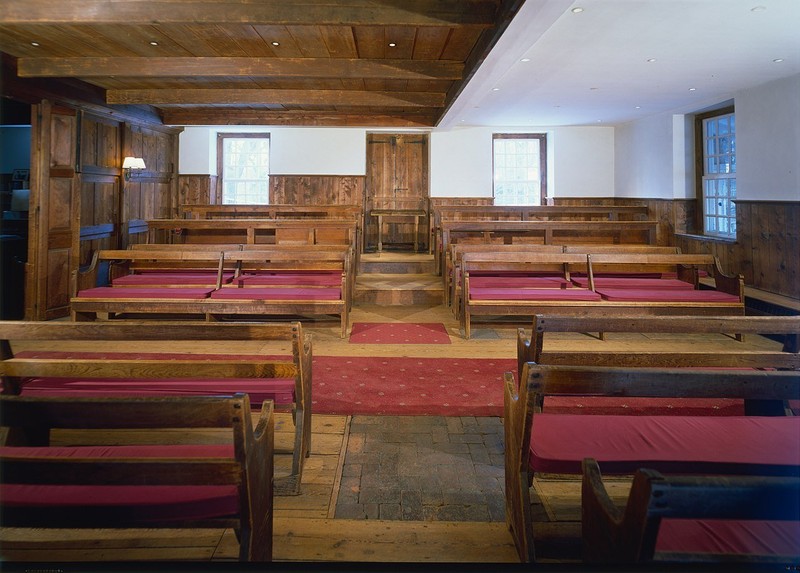Buckingham Friends Meetinghouse
Introduction
Text-to-speech Audio
Images
The Buckingham Friends Meeting House has served the needs of the Buckingham Monthly Meeting since 1768.

The interior of the meetinghouse. Notice the moveable partition on the left.

The National Historic Landmark plaque that adorns the building's exterior.

The associated cemetery has over 2,500 headstones, some dated as early as the 1790s.

The meetinghouse hosts numerous weddings and other social events throughout the year.

It also hosts an annual Peace Fair.

Backstory and Context
Text-to-speech Audio
Members of the Society of Friends from England settled in the area just north of Philadelphia in the early 18th century. However, some, like those in Buckingham, had to travel long distances to other meetinghouses. Members of the Buckingham Monthly Meeting traveled to the Falls Meeting in southern Bucks County as early as 1702. (Quaker communities are referred to as monthly meetings as they hold community business meetings on a monthly basis). In 1705, a member of the Falls Meeting donated ten acres to the Buckingham Meeting and they quickly built a log meetinghouse on the site. They were then granted their own monthly meeting in 1720. That meetinghouse was either expanded or re-built entirely later. It is not certain which.
What is certain, a new meetinghouse was built between 1729 and 1731 and as the meeting expanded, talk of a larger meetinghouse ensued as early as 1750. However, a new location could not be agreed upon. Unfortunately, that meetinghouse burned down, which forced the Friend’s hand and construction on the current meetinghouse began in 1767 under the supervision of Thomas Smith and Joseph Ellicott. Mathias Hutchinson was the master builder and it is assumed he was the architect as well. Built of local stone, the simple but sturdy meetinghouse was completed in 1768.
What makes this meetinghouse unique among all others was its design which was, and still is, committed to gender equality. Certain practices have been part of Quakerism since its founding such as pacifism, humility, and the equality of all members. While Quakers worship together, monthly community business meetings were separated by gender with each having responsibility in certain areas. For example, women oversaw things such as marriages, child rearing and infidelity. However, the accommodations for the women’s meetings were usually smaller and more austere than their male counterparts. The Buckingham Meeting House was the first in the country to change that practice.
This change in practice was due to the Quietist movement during which the Friends turned inward and more insular after the French and Indian War and its associated violence. Members could now be expelled from the Society of Friends if they married “outside the meeting.” Since religious morals and matrimony rules were now being enforced, and since that enforcement fell under the purview of female members, the Buckingham Meeting decided they required equal quarters in which to conduct their monthly business meetings. Thus, Hutchinson designed a meetinghouse with two sets of double doors on each side with a moveable partition down the center. This design would then be emulated among other Quaker communities for over a century.
The Buckingham Meetinghouse has remained largely intact since its construction with minor alterations coming with improved technology, such as indoor plumbing, electricity, and heating. It is still utilized every First Day (Sunday) for the community’s spiritual needs and, as always, welcomes visitors to include the spiritually curious. Singing begins every Sunday at 10:15 with hour long worship beginning at 10:30.
Sources
"A Brief History of the Meetinghouse of Buckingham Meeting." Buckingham Friends Meetings. Accessed January 15, 2019. https://sites.google.com/site/buckinghamfriendsmeeting/Home/meetinghouse
LaVo, Carl. "Buckingham Quaker meeting house nationally recognized for women's rights." Bucks County Courier Times. August 27, 2018. Accessed January 15, 2019. http://www.buckscountycouriertimes.com/news/20180827/lavo-buckingham-quaker-meeting-house-nationally-recognized-for-womens-rights
LaVouie, Catherine. "National Register of Historic Places Nomination Form." United States Department of the Interior/National Park Service. August, 2001. Accessed January 15, 2019. https://focus.nps.gov/GetAsset?assetID=c717837d-b9ee-434f-b069-51e27d1b39c3
